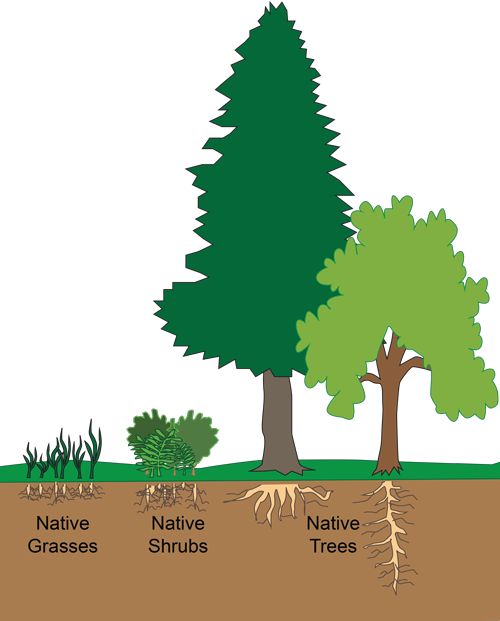 Protecting our environment, one stormwater practice at a time.
Protecting our environment, one stormwater practice at a time.
Open Space — Reforestation
Overview
Reforestation involves planting a mixture of native overstory trees, understory trees and shrubs on existing turf or barren ground at a site with the explicit goal of establishing a mature forest canopy that will intercept rainfall, increase evapotranspiration rates and enhance soil infiltration rates.
 How Reforestation Practices Work
How Reforestation Practices Work
Reforestation reduces the peak rate and volume of stormwater runoff and improves water quality through interception of rainfall by the leaf layer, nutrient uptake, evapotranspiration and infiltration into the soil. Reforestation improves the soil infiltration rate as the tree roots break up compacted soil layers and slow down runoff over these areas. Replacing turf or barren ground with a forest provides many benefits, including.
- Intercepted rainfall
- Wildlife food and habitat
- Improved water quality
- Groundwater recharge
- Increased evapotranspiration
- Improved soil infiltration
- Erosion control
- Reduced greenhouse gases
How to Maintain a Reforestation Practice
- Water once weekly during the first two months, then as needed during the growing season
- Apply 2 to 3 inches of mulch annually over the drip line of the tree
- Prune as needed in early spring
- Mow surrounding grass twice per year during the first three growing seasons to a height of 6 inches
- Do not allow weeds to exceed 12 to 14 inches before mowing
- Inspect the area annually for tree health and signs of erosion
- Remove any tree stakes, guide wires and tree shelters (tubes) two to three years after installation
FairFacts
- Trees provide shade which cools the surrounding areas, reducing the energy demand for cooling during the summer months.
- A tree absorbs approximately 27 pounds of carbon dioxide (CO2) per year.
- Native plants and trees have spent years adapting to the local soil, climate and pests. Non-native plants that are imported from different climates require more water, fertilizer and insecticides than native plants.
- Site reforestation can be used with soil amendments to improve the stormwater runoff reduction of the reforested area.
- Successful reforestation is dependent on frequent watering during the first one to two years.
The information in this fact sheet is general in nature and is not intended to determine maintenance responsibility.
For more information, contact:
Department of Public Works and Environmental Services, Maintenance and Stormwater Management Division
10635 West Drive, Fairfax, VA 22030
703-877-2800, TTY 711
ContactMSMD@fairfaxcounty.gov

